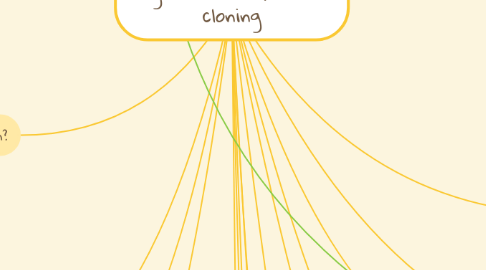Legalisation of human cloning
by Celeste ROY

1. Guidelines
2. Giving humans the right to create and destroy other 'humans'?
2.1. Very strong shift in power balance and authority? Giving figures the RIGHT TO GIVE LIFE and TAKE IT AWAY
3. Culture/religion?
3.1. 'Majority of religions and cultures teach that humans are created by god, and they return back to God
3.1.1. "Culture is acquired by every person from parents, relatives, and neighbors and from the whole human environment. Acquired cultural traits may be beneficial but also toxic; for example, racial prejudice or religious bigotry. Biological heredity is Mendelian or vertical; it is transmitted from parents to their children, and only inherited traits can be transmitted to the progeny." Ayala1, 2015 Retreived from: central
3.2. Human life should not be altered with or taken away.
3.2.1. Breaking both biological and cultural boundaries?
4. Where is reproductive cloning currently legalised?
4.1. US: California
5. Possible solutions?
6. 'human origins, natural selection, cultural evolution, genetic therapy, therapeutic cloning'
7. Where is therapeutic cloning currently legalised?
7.1. "England, Singapore, Sweden, China and Israel allow cloning for research, but prohibit it for reproduction". Accessed at NPR : Special Report: Cloning
8. Are they even human? Do they still deserve those rights?
8.1. How would society consider 'unnatural' people?
9. Human rights?
9.1. Ethics? Test subjects?
10. Advantages of human cloning ?
10.1. Test subjects? Is there a way to create a human that is neurally altered to not feel physical or emotional pain
10.2. Possible replacement for animal testing
10.2.1. But, still some would consider this testing to by more inhumane because you are testing on a mentally RETARDED human?
11. History of human cloning
12. Process of human cloning
13. 5000 BC- Massive agricultural progress made when humans realise through taking seeds from the best crops, they can improve their farming practises/crops (University of Utah, 2017).
14. 1902- Hans Spemann discovers that early embryo cells contain all the genetic information required to produce a living creature- he does this through splitting and observing salamander embryos at their early stages (University of Utah, 2017).
15. 1928- Hans Spemann performs a ‘nuclear transfer’ experiment between two salamander embryos University of Utah, 2017. This was an important milestone within cloning, as this served as the basis for which reproductive and therapeutic cloning could be carried out.
16. As stated by the Howard Hughes Medical Institute (2017), the process works when the nucleus of a young body cell (ie. a skin cell) is removed, and the nucleus of a egg cell is removed. The nucleus from the skin cell is implanted into the egg cell, and cell division begins, so the clone begins forming
17. 1952- Robert Briggs and Thomas King setup the protocol to perform a successful nuclear transplant at the Institute for Cancer Research and Lankenau Hospital Research Institute in Philadelphia, Pennsylvania (Bartlett, 2014)- a Rana pipiENS frog was cloned and the development of the embryo was normal, however, it only grew until the tadpole stage before it died (Brownlee, 2017).
18. 1996- Ian Wilmut replaces the nucleus of an egg cell of an adult sheep with the nucleus from another sheep’s udder. Embryo is placed into surrogate mother and Dolly (Rogers, 2009), the first cloned mammal from an adult egg cell, is born.
19. 1998: Stem cells within the embryo are successfully isolated (from the embryo) for the first time. These cells can turn into any of the cells within the body and thus, can potentially be cloned to replace cells and organs damaged by disease (BBC, 2014).



